The IBM POWER8 Review: Challenging the Intel Xeon
by Johan De Gelas on November 6, 2015 8:00 AM EST- Posted in
- IT Computing
- CPUs
- Enterprise
- Enterprise CPUs
- IBM
- POWER
- POWER8
Taking a Closer Look At IBM's S822L
The S822L was mounted in the Xeon server dominated racks inside our experimental datacenter. The build quality of both the rails and server were apparent, a "locking mechanism" made sure the server was easy to mount without a screwdriver and was kept firmly at its place.
The system booted by using the Flexible Service Processor (FSP), which is comparable to the Baseboard Management Controllers as they are both components that allow you to manage and monitor your server thanks to the IPMI specification. The main difference with Xeon system is that the FSP and its related firmware and software is the only way you can control your system. There is no "BIOS" screen or BIOS configuration setup, everything has to be configured and booted via the FSP software. You could say that the "BIOS" and "BMC management software" are now integrated into one central firmware.
To power on the S822L, you have to access the FSP using the open-source IPMItool. Once the server is booted up, the "petitboot" bootloader of OPAL (the OpenPOWER Abstraction Layer firmware) takes over. It scans all bootable instances (disks, network, optical, etc.) for operating systems, and is similar to the GRUB bootloader. From there, you can install Linux like you would on an x86 system.
The cover was covered with a lot of interesting service information about the upgrading and replacing the hardware.
Once we removed the cover, lots of expansion slots became visible.
No less than nine hot plug (!) low profile PCIe Gen 3 slots are available. Four of them are x16, ready for some GPU action. Five are x8. Only one of the PCIe slots is used for the standard quad-gigabit Ethernet adapter. We also had one Emulex FC card installed.
Also installed were two PowerPC based SAS RAID controller(s), capable of RAID-6 and all common RAID levels, which connectto a dual backplane that offers 12 Small Factor Form (2.5 inch) drives. These drives can be SAS SSD or hard disks, which is a reliable but rather expensive storage choice. A DVD drive was also present, which allowed us to install Linux the old-fashioned way.
At the back we find two hot-swappable PSUs, four gigabit Ethernet interfaces, two USB 2.0 ports, an HMC dual-gigabit interface (an HMC is a hardware applicance that can manage several IBM servers) and one system port.
The server is powered by two redundant high quality Emerson 1400W PSUs.


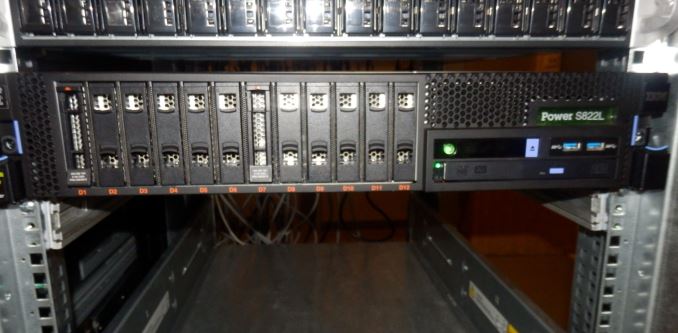
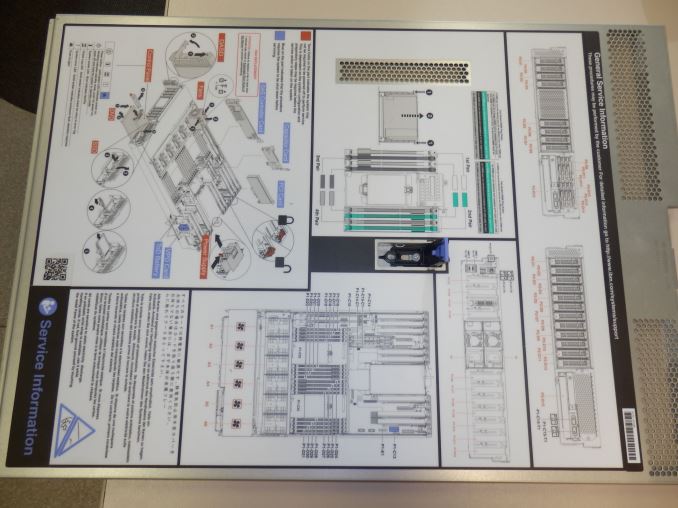
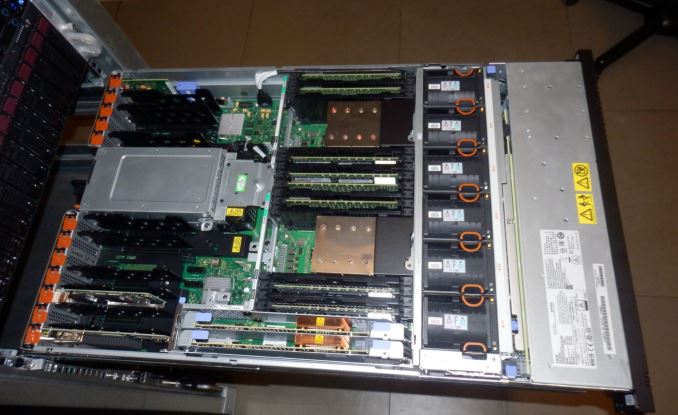
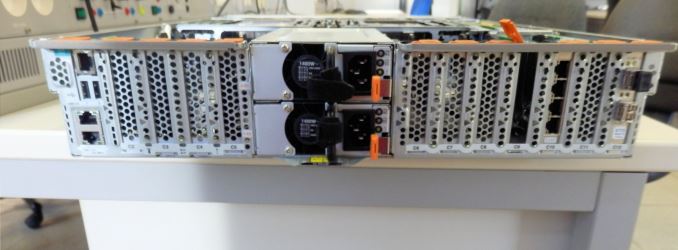
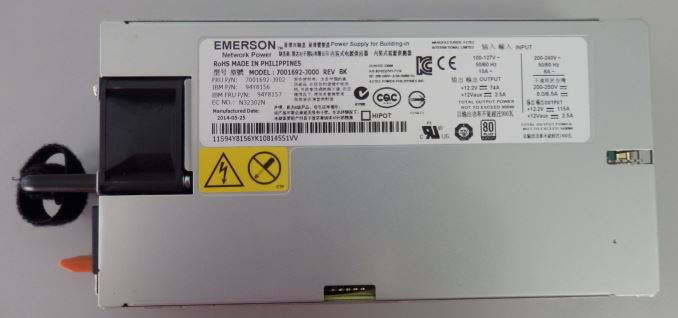








146 Comments
View All Comments
JohanAnandtech - Saturday, November 7, 2015 - link
suggestions on how to to do this? OpenSSL 1.02 will support the build in crypto accelerator, but I am not sure on how I would be able to see if the crypto code uses VMX.SarahKerrigan - Monday, November 9, 2015 - link
Compile with -qreport in XL C/C++.Oxford Guy - Saturday, November 7, 2015 - link
Typo on page 2:The resuls are that Google is supporting the efforts and Rackspace has even build their own OpenPOWER server called "Barreleye".
Ryan Smith - Saturday, November 7, 2015 - link
Thanks.iwod - Saturday, November 7, 2015 - link
In terms of 100, POWER Software Ecosystem manage to scale from 10 to 20, so that is a 100% increase but still very very low. Will we see POWER CPU / Server that is cheap enough to compete with Xeon E3 / E5, where most of the volume are? Compared to E7 is like comparing Server CPU for the 10% of the market.Intel will be moving to 14nm E7, I don't see anyone making POWER CPU at 14nm anytime soon.
Intel DC business are growing, and it desperately need a competitor, such as POWER to combat E7 and AMD Zen from the bottom.
Frenetic Pony - Saturday, November 7, 2015 - link
Nice review! It just confirms my question however of "What does IBM do?" Seriously, what do they do anymore? All I see are headlines for things that never come out as actual products. Their servers suck up too much power per watt, they don't have their own semi conductor foundries, their semi conductor research seems like a bunch of useless paper tiger stuff, their much vaunted AI is better at playing Jeapordy than seemingly any real world use.Countdown to complete IBM bankruptcy/spinoff/selloff is closer than ever.
ws3 - Saturday, November 7, 2015 - link
Since the dawn of computing, IBM has been in the business of providing solutions, rather than merely hardware. When you buy IBM you pay a huge amount of money, and what you get for that is support, with some hardware thrown in.Obviously this only appeals to wealthy customers who don't have or don't want to have an internal support organization that can duplicate what IBM offers. It seems to me that the number of such customers is decreasing over time, but as long as the US government is around, IBM will have at least one customer.
xype - Sunday, November 8, 2015 - link
They make 2-5 Billion dollars of profit per quarter. "Countdown to complete IBM bankruptcy/spinoff/selloff is closer than ever." my ass.PowerTrumps - Sunday, November 8, 2015 - link
Pretty fair and even handed review; don't agree with it all and definitely feel there is room to learn and improve. Btw, full disclosure, I am a System Architect focusing on Power technology for a Business Partner.With regard to compilers I would suggest IBM's SDK for Linux on Power & Advanced Tool Chain (ATC) provide development tools and open source optimized dev stack (ie gcc) for POWER8. Details at: https://www-304.ibm.com/webapp/set2/sas/f/lopdiags... and https://www.ibm.com/developerworks/community/wikis...
MySQL is definitely relevant but with the new Linux distro's packaging MariaDB in place of MySQL I would have liked to see an Intel vs Power comparison with this MySQL alternative. MariaDB just announced v10.1 is delivering over 1M queries per second on POWER8. https://blog.mariadb.org/10-1-mio-qps/
A commenter asked about Spark with POWER8. This blog discusses how it performs vs Intel. https://www.ibm.com/developerworks/community/blogs...
In addition to the commercial benchmarks often quoted such as SPEC, SAP and TPC like this SAP HANA result with SUSE on POWER8 ; SAP BW-EML (ie HANA) shows tremendous scaling with POWER8. http://www.smartercomputingblog.com/power-systems/... many of the ISV's have produced their own. I have seen results for PostgreSQL, STAC (http://financial.mcobject.com/press-release-novemb... Redis Labs, etc.
Benchmarks are great, all vendors do them and most people realize you should take them with a grain of salt. One benefit of Power servers when using PowerVM, its native firmware based hypervisor is that it delivers tremendous compute efficiency to VM's. On paper things like TDP seem higher for Power vs Intel (especially E5_v3 chips) but when Power servers deliver consolidation ratio's with 2-4X (and greater) more VM's per core the TCA & TCO get real interesting. One person commented how SAP on Power would blow out a budget. It does just the opposite because how you can run in a Tier-2 architecture obtaining intra-server VM to VM efficiencies, compute efficiencies with fewer cores & servers which impacts everything in the datacenter. Add in increased reliability & serviceability features and you touch the servers less which means your business is running longer.
And for more details on the open platform or those based on the OpenPOWER derivative using the "LC" designator such as S822LC in contrast to the S822L used as the focus in this article. http://www.smartercomputingblog.com/power-systems/... and http://businesspartnervoices.com/ibm-power-systems...
JohanAnandtech - Sunday, November 8, 2015 - link
Great feedback. We hope to get access to another POWER8(+) server and build further upon our existing knowledge. We have real world experience with Spark, so it is definitely on the list. The blog you linked seems to have used specific SPARK optimization for POWER, but the x86 reference system looks a bit "neglected". A real independent test would be very valuable there. The interesting part of Spark is that a good benchmark would be also very relevant for the real world as peak performance is one of the most important aspects of Spark, in contrast with databases where maximum performance is only a very small part of the experience.About MySQL, people have pointed out that the 5.7 version seems to scale a lot better, so that is together with MariaDB also on my "to test" list. Redis does not seem relevant for this kind of machine, it is single-threaded, almost impossible to test 160 instances.
The virtualization part is indeed one of the most interesting parts, but it is a benchmarking nightmare. You got to keep response times at more or less the same levels while loading the machine with more and more VMs. We did that kind of testing until 2 years ago on x86, but it was very time consuming and we had a deep understanding on how vSphere worked. Building that kind of knowledge on PowerVM might be beyond our manpower and time :-).